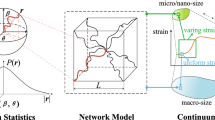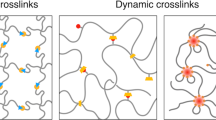Abstract
Stress–strain relations are derived for the mechanical response of elastomers at arbitrary three-dimensional deformations with finite strains. An elastomer is treated as an incompressible network of chains bridged by permanent (chemical cross-links and physical cross-links whose lifetime exceeds the characteristic time of deformation) and temporary (entanglements modeled as slip-links) junctions. Two types of chains are introduced in the network to distinguish between permanent and temporary nodes. Type-I chains have free ends, and their motion at the micro-level is constrained by a random number of slip-links. Type-II chains are Gaussian chains permanently connected to the network. Concentration of type-I chains is fixed, while the number of type-II chains per unit volume can change under deformation. The governing equations involve two (networks with constant concentrations of type-II chains) or three (networks where the content of type-II chains is affected by mechanical factors) material parameters. These parameters are found by fitting observations on rubbers, thermoplastic–elastomers, and thermoplastic-elastomer composites. Good agreement is demonstrated between the experimental data in uniaxial tensile tests and the results of numerical simulation at elongations up to 1,000%. It is shown that the adjustable parameters are affected by chemical composition and molecular architecture of polymers in a physically plausible way.
Similar content being viewed by others
References
Drozdov, A.D.: Polymer networks with slip-links: 1. Constitutive equations for an uncross-linked network. Continuum. Mech. Thermodyn. (2006) (in press)
Holden G. (2000). Understanding Thermoplastic Elastomers. Hanser/Gardner Publications, Munich
Holden G., Kricheldorf H.R., Quirk R.P. (eds) (2004). Thermoplastic Elastomers, 3rd edn. Hanser/Gardner Publ, Munich
Spontak R.J., Patel N.P. (2000). Thermoplastic elastomers: fundamentals and applications. Curr. Opin. Coll. Interface Sci. 5:334–341
Metzler R., Hanke A., Dommersnes P.G., Kantor Y., Kardar M. (2002). Tightness of slip-linked polymer chains. Phys. Rev. E 65: 061103
Masubuchi Y., Takimoto J.-I., Koyama K., Ianniruberto G., Marrucci G., Greco F. (2001). Brownian simulations of a network of reptating primitive chains. J. Chem. Phys. 115:4387–4394
Ball R.C., Doi M., Edwards S.F., Warner M. (1981). Elasticity of entangled networks. Polymer 22:1010–1018
Bensason S., Stepanov E.V., Chum S., Hiltner A., Baer E. (1997). Deformation of elastomeric ethylene-octene copolymers. Macromolecules 30:2436–2444
Haward R.N. (1999). The application of non-Gaussian chain statistics to ultralow density polyethylenes and other thermoplastic elastomers. Polymer 40:5821–5832
Lambert-Diani J., Rey C. (1999). New phenomenological behavior laws for rubbers and thermoplastic elastomers. Eur. J. Mech. A/Solids 18:1027–1043
Boyce M.C., Kear K., Socrate S., Shaw K. (2001). Deformation of thermoplastic vulcanizates. J. Mech. Phys. Solids 49:1073–1098
Marzocca A.J., Goyanes S. (2004). An analysis of the influence of the accelerator/sulfur ratio in the cure reaction and the uniaxial stress–strain behavior of SBR. J. Appl. Polym. Sci. 91:2601–2609
Montoya M., Tomba J.P., Carella J.M., Gobernado-Mitre M.I. (2004). Physical characterization of commercial polyolefinic thermoplastic elastomers. Eur. Polym. J. 40:2757–2766
Sheth J.P., Xu J., Wilkes G.L. (2003). Solid state structure–property behavior of semicrystalline poly(ether-block-amide) PEBAX thermoplastic elastomers. Polymer 44:743–756
Saikrasun S., Bualek-Limcharoen S., Kohjiya S., Urayama K. (2005). Anisotropic mechanical properties of thermoplastic elastomers in situ reinforced with thermotropic liquid-crystalline polymer fibres revealed by biaxial deformations. J. Polym. Sci. [B]: Polym Phys 43:135–144
Schmaltz H., Abetz V., Lange R., Soliman M. (2001). New thermoplastic elastomers by incorporation of nonpolar soft segments in PBT-based copolyesters. Macromolecules 34:795–800
Rajan G.S., Vu Y.T., Mark J.E., Myers C.L. (2004). Thermal and mechanical properties of polypropylene in the thermoplastic elastomeric state. Eur. Polym. J. 40:63–71
Schonherr H., Wiyatno W., Pople J., Frank C.W., Fuller G.G., Gast A.P., Waymouth R.M. (2002). Morphology of thermoplastic elastomers: elastomeric polypropylene. Macromolecules 35:2654–2666
Bensason S., Minick J., Moet A., Chum S., Hiltner A., Baer E. (1996). Classification of homogeneous ethylene-octene copolymers based on comonomer content. J. Polym. Sci. [B]: Polym. Phys. 34:1301–1315
Gabrielse W., Soliman M., Dijkstra K. (2001). Microstructure and phase behavior of block copoly(ether ester) thermoplastic elastomers. Macromolecules 34:1685–1693
Gabrielse W., van Guldener V., Schmalz H., Abetz V., Lange R. (2002). Morphology and molecular miscibility of segmented copoly(ether ester)s with improved elastic properties as studied by solid state NMR. Macromolecules 35:6946–6952
Litvinov V.M., Bertmer M., Gasper L., Demco D.E., Blumich B. (2003). Phase composition of block copoly(ether ester) thermoplastic elastomers studied by solid-state NMR techniques. Macromolecules 36:7598–7606
Schmalz H., van Guldener V., Gabrielse W., Lange R., Abetz V. (2002). Morphology, surface structure, and elastic properties of PBT-based copolyesters with PEO-b-PEB-b-PEO triblock copolymer soft segments. Macromolecules 35:5491–5499
Kwon Y., Antony P., Paulo C., Puskas J.E. (2002). Arborescent polyisobutylene–polystyrene block copolymers—A new class of thermoplastic elastomers. Polymer Prepr. ACS 43(1):266–267
Puskas J.E., Chen Y. (2004). Biomedical application of commercial polymers and novel polyisobutylene-based thermoplastic elastomers for soft tissue replacement. Biomacromolecules 5:1141–1154
Unal S., Yilgor I., Yilgor E., Sheth J.P., Wilkes G.L., Long T.E. (2004). A new generation of highly branched polymers: hyperbranched, segmented poly(urethane urea) elastomers. Macromolecules 37:7081–7084
Kelarakis A., Yoon K., Sics I., Somani R.H., Hsiao B.S., Chu B. (2005). Uniaxial deformation of an elastomer composite containing modified carbon nanofibres by in situ synchrotron X-ray diffraction. Polymer 46:5103–5117
Sheng Y.-J., Lai P.-Y., Tsao H.-K. (2000). Deformation of a stretched polymer knot. Phys. Rev. E. 61:2895–2901
Lai P.-Y. (2002). Dynamics of polymer knots at equilibrium. Phys. Rev. E. 66:021805
Author information
Authors and Affiliations
Corresponding author
Additional information
Communicated by A. DeSimone
Rights and permissions
About this article
Cite this article
Drozdov, A.D. Polymer Networks with Slip-links: 2. Constitutive Equations for a Cross-linked Network. Continuum Mech. Thermodyn. 18, 171–193 (2006). https://doi.org/10.1007/s00161-006-0021-x
Received:
Accepted:
Published:
Issue Date:
DOI: https://doi.org/10.1007/s00161-006-0021-x




